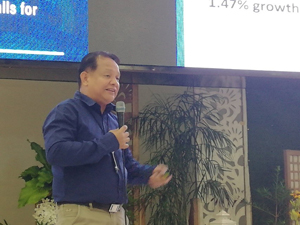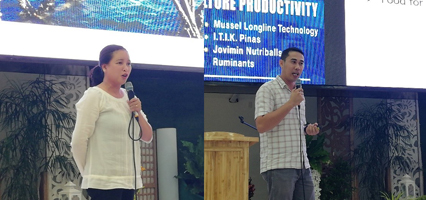 Committed to share and promote the results of its R&D efforts, the Philippine Council for Agriculture, Aquatic, and Natural Resources Research and Development of the Department of Science and Technology (DOST-PCAARRD) again participated in the Regional Science and Technology Week (RSTW) held at the Don Leopoldo Sison Convention Hall, Alaminos City, Pangasinan.
Committed to share and promote the results of its R&D efforts, the Philippine Council for Agriculture, Aquatic, and Natural Resources Research and Development of the Department of Science and Technology (DOST-PCAARRD) again participated in the Regional Science and Technology Week (RSTW) held at the Don Leopoldo Sison Convention Hall, Alaminos City, Pangasinan.
Through its exhibits and displays, DOST-PCAARRD featured the technologies on artificial insemination (AI) in goats, Itik Pinas, and enhancing peanut productivity through boron fertilization.
AI, though not a new technology, has again been promoted to address the need to improve the genetic make-up of native goats. DOST-PCAARRD and the Isabela State University (ISU), through the project, aimed to increase awareness and knowledge on the technology and its protocols to attain at least 85% conception rate and rapidly spread genetically superior breeds in the region.
The protocols include doe selection, doe management before breeding, insemination, and doe management after insemination. With the infusion of quality genetics in smallholder farms through AI, increase in average birth weight by 43% (1.5-2.21 kg) and slaughter weight by 80% (15 kg to 27 kg) is achieved
The display on Itik Pinas highlighted the three different strains – IP-Itim and IP-Khaki, which are both purelines, and IP-Kayumanggi, a crossbreed of the two purelines. These strains are the first and only Philippine layer duck breed developed through organized breeding and selection to address the industry problem of low and inconsistent egg production performance and product quality of the traditional mongrel ducks.
Among the benefits of Itik Pinas are increased predictability in egg production performance with consistent product quality; increased average egg produced per duck per year from 201 eggs to 266 eggs; and stable supply and accessibility of breeder ducks and duck egg products.
On the other hand, the application of boron as a micronutrient fertilizer in peanut production aimed to enhance growth and development of the crop. The application of boron (Solubor Borax and Fertibor) significantly increased peanut yield, contributing to yield increment of 627-693 kg/ha for BPI Pn 9 variety, 709-1,097 kg/ha for NSIC Pn 15 (Asha) variety, and 1,641-1907 kg/ha for NSIC Pn 14 (Namnama 2) variety.
 Supplementing the exhibits, a series of lectures through the Technology Fora was also organized during the four-day event. AI was discussed by Dr. Jonathan Nayga of ISU; Ms. Mary Grace Baniqued-Gatan of the Pampanga State Agricultural University (PSAU) presented the enhanced peanut productivity thru boron fertilization; and Mr. Jamal James Manlapig of the Central Luzon State University (CLSU) introduced the Itik Pinas.
Supplementing the exhibits, a series of lectures through the Technology Fora was also organized during the four-day event. AI was discussed by Dr. Jonathan Nayga of ISU; Ms. Mary Grace Baniqued-Gatan of the Pampanga State Agricultural University (PSAU) presented the enhanced peanut productivity thru boron fertilization; and Mr. Jamal James Manlapig of the Central Luzon State University (CLSU) introduced the Itik Pinas.
Other DOST-PCAARRD-supported technologies discussed during the fora include: Mussel longline technology, BioGroe Biofertilizer, and Myko Plus Biofertilizer.
The DOST-PCAARRD technologies presented aimed to contribute in the development of local agricultural industries across the region.
The RSTW held at the Don Leopoldo Sison Convention Hall, Alaminos City, Pangasinan was organized by DOST Region 1 and hosted by the Local Government of Alaminos. It was participated in by national and regional offices and agencies of DOST; state universities and colleges in the region; private sector; and local and national media partners.
